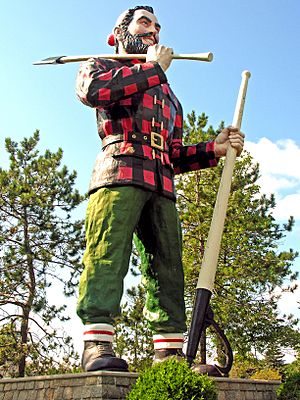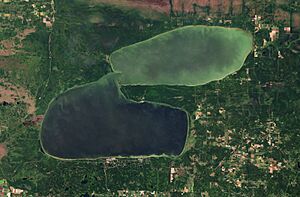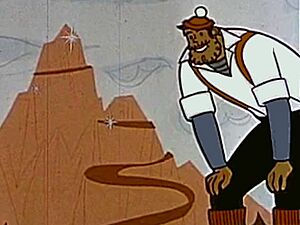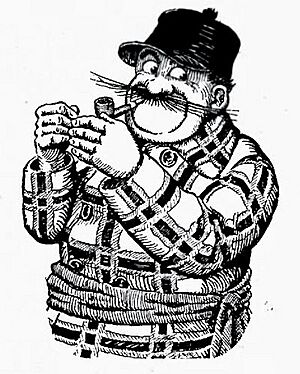Paul Bunyan facts for kids
Quick facts for kids Paul Bunyan |
|
|---|---|

Paul Bunyan statue in Bangor, Maine
|
|
| Birthplace | Various claimed: |
| Information | |
| Species | Giant |
| Occupation | Lumberjack |
| Nationality | French-Canadian/Canadian/American |
Paul Bunyan is a famous giant lumberjack and folk hero. He appears in many American and Canadian folklore stories. These stories are called tall tales because they are greatly exaggerated. Paul Bunyan is known for his amazing strength and superhuman work. He is always with his best friend, Babe the Blue Ox, who is also his working animal.
Paul Bunyan's character first came from stories told by North American loggers. Later, a writer named William B. Laughead helped make him famous. Laughead wrote about Paul Bunyan in a 1916 advertisement for a lumber company. Since then, Paul Bunyan has been in books, songs, and plays. You can even see many large statues of him across North America.
Contents
What's in a Name?
People have many ideas about where the name Paul Bunyan came from. Many think it has French-Canadian roots. The sound of "Bunyan" is similar to a French-Canadian saying, "bon yenne!" This phrase shows surprise. The English last name Bunyan also comes from an Old French word, bugne. This word means a large lump or swelling. Some researchers believe Paul Bunyan might be linked to a French-Canadian character named Bon Jean.
How Paul Bunyan Became Famous
In 1916, a writer named William B. Laughead created an advertisement for the Red River Lumber Company. He used the Paul Bunyan character in his ads. Laughead's first ad was not very successful. But his second one, called "Tales about Paul Bunyan, Vol. II," became very popular.
Laughead changed some of the old stories he heard from loggers. He added new details and made the tales even bigger. For example, Laughead gave the blue ox the name "Babe." He also drew the first pictures of Paul Bunyan. In Laughead's stories, Paul Bunyan was incredibly tall, towering over trees. In older folk tales, he was strong and tall, but still more human-sized.
Laughead's stories said that Paul Bunyan and Babe created many famous places in America. For instance, they supposedly made the 10,000 lakes of Minnesota with their giant footprints. Later writers added more details. They said Paul Bunyan created Lake Bemidji because it looks like a giant footprint from above. Other authors even claimed he made the Grand Canyon by dragging his axe. They also said he made Mount Hood by putting stones on his campfire.
Some later stories even gave Paul Bunyan a wife. In one tale, she is called "Mrs. Paul" and has a daughter named "Tiny." Another story says Paul rescued a red-haired giant-lady named "Sylvia." She was trapped under snow. They fell in love and got married the same day.
Because of all these new stories, some people wondered if Paul Bunyan was a real folk character. But later research showed that he was indeed part of old logging traditions. Laughead's pamphlets are still popular today. They are collected in a book called The Marvelous Exploits of Paul Bunyan.
Paul Bunyan in Ojibwe Stories

The Ojibwe people, a Native American tribe, also have stories about Paul Bunyan. They connected him to their own hero, Nanabozho.
In one Ojibwe story, Paul Bunyan came to cut down trees in Northern Minnesota. Nanabozho fought him to protect the forest. They battled for three days. Finally, Bunyan was knocked down into the mud. This created Red Lake, Minnesota. The story says this fight is why the lake has its unique shape. It also explains why the Chippewa National Forest and Boundary Waters Canoe Area Wilderness were saved.
Paul Bunyan for Kids

Paul Bunyan stories have become very popular for children. Most of these kid-friendly versions add even more details to Laughead's original pamphlets. They usually do not include much from the older oral traditions. These books often tell Paul Bunyan's story from when he was a baby until he grew up. They always make him incredibly huge.
Some popular children's books about Paul Bunyan include:
- Paul Bunyan by Esther Shephard
- Paul Bunyan by James Stevens
- Paul Bunyan Swings His Axe by Dell J. McCormick
- Paul Bunyan and His Great Blue Ox by Wallace Wadsworth
- The Marvelous Exploits of Paul Bunyan by William Laughead
In 1958, Walt Disney Studios made an animated short film called Paul Bunyan. In the film, Paul competes in a tree-chopping contest against a steam-powered saw. The movie was nominated for an Academy Award for Best Animated Short Film.
Paul Bunyan also appeared in a 1963 episode of The Magical World of Disney. In the 1995 Disney movie Tall Tale, Paul Bunyan is played by Oliver Platt. In this movie, Paul is an average-sized man. But he has a huge personality that fits the film's exaggerated style.
In a 2007 story, Paul Bunyan's Sweetheart, Paul marries a giant woman named Lucette Diana Kensack. She teaches him how to be a forester. This means replanting trees after logging. In 2017, an animated movie called Bunyan and Babe was released. John Goodman voiced Paul Bunyan in this film.
Is Paul Bunyan Real?
Many people wonder if Paul Bunyan was a real person. Some experts, like K. Bernice Stewart, studied the old stories. She interviewed loggers in the Midwest in 1916. She found that many stories about Paul Bunyan already existed. They were just told around a central character. Stewart believed Paul Bunyan stories were like "traveler's tales." These are stories told by people who travel a lot.
Some loggers Stewart interviewed even claimed to have known Paul Bunyan or his crew. They even pointed out where his grave supposedly was in northern Minnesota. However, the idea of Paul Bunyan being a super-giant came later. Early stories often said he was about seven feet tall, which is very tall, but not impossibly huge.
Other researchers, like Michael Edmonds, also looked into the Paul Bunyan tradition. He found that the stories started in logging camps in Wisconsin around the early 1900s. But they became much bigger and more popular because of companies using them for advertising.
Some people think Paul Bunyan is "fakelore." This means it's a made-up story that tries to seem like an old folk tale. They point out that many Paul Bunyan books, especially for kids, have parts that were never in the original folk stories. However, this view sometimes ignores the real history of the character in logging camps.
Some authors have suggested that Paul Bunyan might have been based on a real person. One idea is that he was a French-Canadian lumberjack named Fabian "Saginaw Joe" Fournier (1845–1875). Fournier worked as a logger in Michigan. Another idea is that Paul Bunyan was a soldier named Paul Bon Jean from a rebellion in Canada. But these ideas have not been fully proven.
Images for kids
See also
 In Spanish: Paul Bunyan para niños
In Spanish: Paul Bunyan para niños
- Big Joe Mufferaw
- Cordwood Pete, said to be the younger brother of Paul
- Disney's American Legends
- Fearsome critters
- Joe Magarac
- John Henry (folklore)
- Paul Bunyan's Axe (trophy)
- Paul Bunyan (operetta)
- Paul Bunyan Trophy
- Statue of Paul Bunyan (Portland, Oregon)
- Tall tale
- Tall Tale (film)



